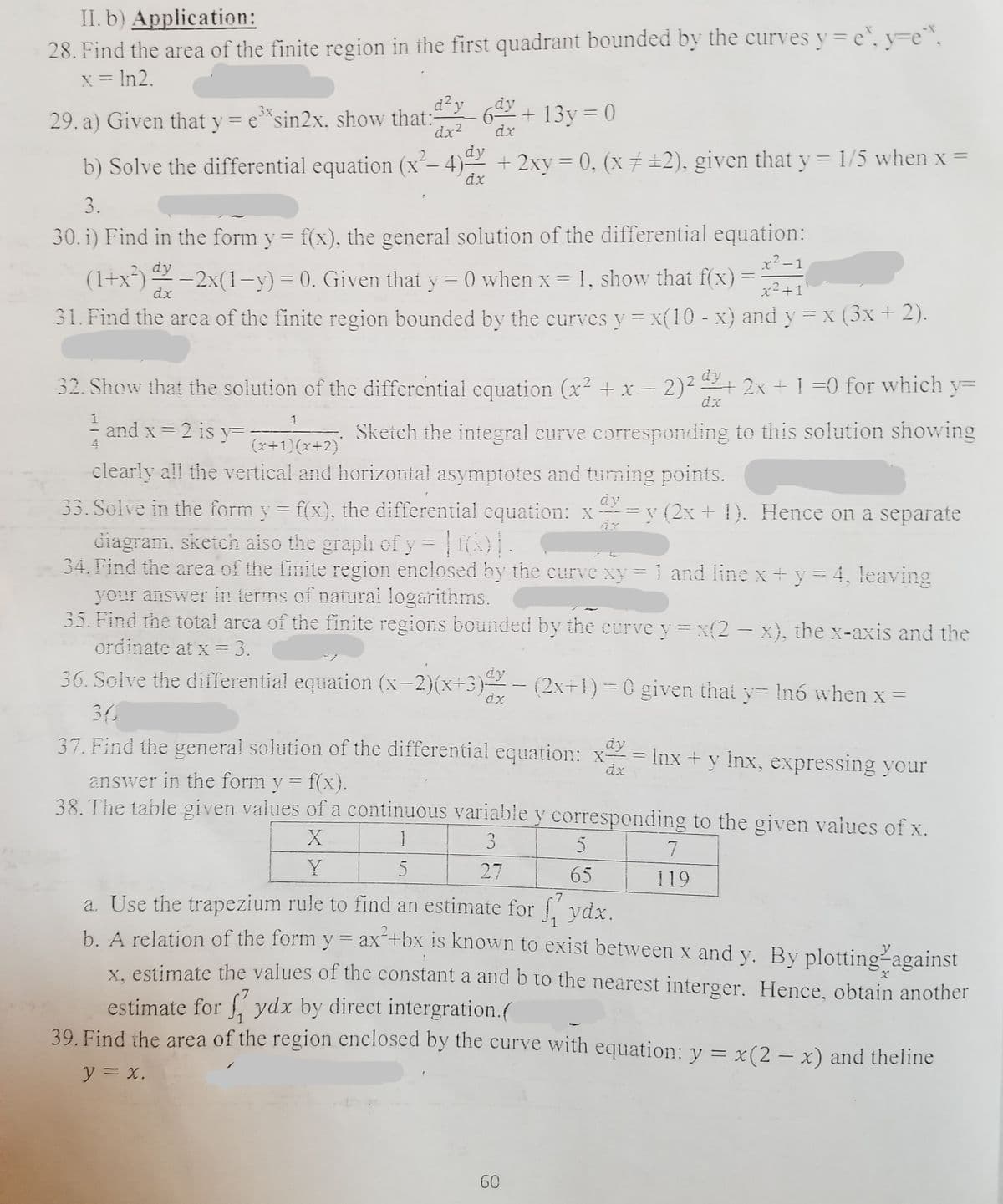Calculus: Early Transcendentals
8th Edition
ISBN:9781285741550
Author:James Stewart
Publisher:James Stewart
Chapter1: Functions And Models
Section: Chapter Questions
Problem 1RCC: (a) What is a function? What are its domain and range? (b) What is the graph of a function? (c) How...
Related questions
Concept explainers
Equations and Inequations
Equations and inequalities describe the relationship between two mathematical expressions.
Linear Functions
A linear function can just be a constant, or it can be the constant multiplied with the variable like x or y. If the variables are of the form, x2, x1/2 or y2 it is not linear. The exponent over the variables should always be 1.
Question
Solve all Q31 explaining detailly each step

Transcribed Image Text:II. b) Application:
28. Find the area of the finite region in the first quadrant bounded by the curves y = e°, y=e*,
x = In2.
d²y
dy
+ 13y = 0
3x
29. a) Given that y = e*sin2x, show that:
dx²
dx
%3D
b) Solve the differential equation (x- 4)-- + 2xy = 0, (x ±2). given that y = 1/5 when x =
dx
3.
30. i) Find in the form y = f(x), the general solution of the differential equation:
dy
x²-1
(1+x*)–-2x(1-y)= 0. Given that y = 0 when x = 1, show that f(x)
31. Find the area of the finite region bounded by the curves y = x(10 - x) and y = x (3x+ 2).
|
dx
x²+1
dy
32. Show that the solution of the differential equation (x + x – 2)-
+ 2x + 1 =0 for which y=
di
1
- and x= 2 is y= Sketch the integral curve corresponding to this solution showing
4
(x+1)(x+2)
clearly all the vertical and horizontal asymptotes and turning points.
áy
33. Solve in the form y = f(x), the differential equation: x
= v (2x + 1). Hence on a separate
diagram, skeich aiso the graph of y = f(x)|.
34. Find the area of the finite region enclosed by the curve xy = 1 and line x+y = 4, leaving
your answer in terms of naturai logarithms.
35. Find the total area of the finite regions bounded by the crve y = x(2- X), the x-axis and the
ordinate at x =
3D3.
36. Solve the differential equation (x-2)(x+3)-- (2x+1)= 0 given that y= In6 when x =
dy
36
37. Find the general solution of the differential equation: x = Inx + y Inx, expressing your
dy
dx
answer in the form y = f(x).
38. The table given values of a continuous variable y corresponding to the given values of x.
1
3
7
27
65
119
a. Use the trapezium rule to find an estimate for vdx.
b. A relation of the form y = ax´+bx is known to exist between x and y. By plotting-against
X. estimate the values of the constant a and b to the nearest interger. Hence, obtain another
7
estimate for f ydx by direct intergration.(
39. Find the area of the region enclosed by the curve with equation: y = x(2 – x) and theline
y = x.
60
2.
Expert Solution
This question has been solved!
Explore an expertly crafted, step-by-step solution for a thorough understanding of key concepts.
Step by step
Solved in 3 steps with 1 images

Knowledge Booster
Learn more about
Need a deep-dive on the concept behind this application? Look no further. Learn more about this topic, calculus and related others by exploring similar questions and additional content below.Recommended textbooks for you

Calculus: Early Transcendentals
Calculus
ISBN:
9781285741550
Author:
James Stewart
Publisher:
Cengage Learning

Thomas' Calculus (14th Edition)
Calculus
ISBN:
9780134438986
Author:
Joel R. Hass, Christopher E. Heil, Maurice D. Weir
Publisher:
PEARSON

Calculus: Early Transcendentals (3rd Edition)
Calculus
ISBN:
9780134763644
Author:
William L. Briggs, Lyle Cochran, Bernard Gillett, Eric Schulz
Publisher:
PEARSON

Calculus: Early Transcendentals
Calculus
ISBN:
9781285741550
Author:
James Stewart
Publisher:
Cengage Learning

Thomas' Calculus (14th Edition)
Calculus
ISBN:
9780134438986
Author:
Joel R. Hass, Christopher E. Heil, Maurice D. Weir
Publisher:
PEARSON

Calculus: Early Transcendentals (3rd Edition)
Calculus
ISBN:
9780134763644
Author:
William L. Briggs, Lyle Cochran, Bernard Gillett, Eric Schulz
Publisher:
PEARSON

Calculus: Early Transcendentals
Calculus
ISBN:
9781319050740
Author:
Jon Rogawski, Colin Adams, Robert Franzosa
Publisher:
W. H. Freeman


Calculus: Early Transcendental Functions
Calculus
ISBN:
9781337552516
Author:
Ron Larson, Bruce H. Edwards
Publisher:
Cengage Learning